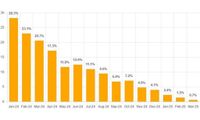Pakistan's headline inflation rate has dropped to a historic low of 0.7% year-on-year in March 2025, according to data released by the Pakistan Bureau of Statistics (PBS) on April 3, 2025. This significant decrease marks a notable decline from the previous month's inflation rate of 1.5%, and it is the lowest reading recorded since December 1965, making it a 59-year low, as highlighted by Arif Habib Limited (AHL) in their recent analysis.
On a month-on-month basis, inflation saw an increase of 0.9% in March 2025, contrasting with a decrease of 0.8% in February and an increase of 1.7% in the same month last year. The average Consumer Price Index (CPI) inflation during the first nine months of the fiscal year 2025 stands at 5.25%, a significant reduction compared to the staggering 27.06% recorded during the same period last year.
The trajectory of inflation in Pakistan has been a pressing economic issue, especially following a peak in May 2023 when the CPI inflation rate soared to an unprecedented 38%. However, recent trends indicate a consistent decline in inflation rates. Just days before the PBS report, the Finance Division projected that headline inflation would remain within the 1-1.5% range for March 2025, with expectations of a slight increase to 2-3% in April 2025.
The Monetary Policy Committee (MPC) of the State Bank of Pakistan (SBP) held its last meeting where it decided to maintain the policy rate at 12%. The committee noted that the lower-than-expected inflation in February was primarily due to a drop in food and energy prices, although it acknowledged the risks posed by the inherent volatility in these sectors. They cautioned that while overall inflation is declining, core inflation remains stubbornly high, which could lead to future increases in the inflation rate.
In terms of urban and rural inflation, the data reveals a contrasting picture. Urban CPI inflation decreased to 1.2% year-on-year in March 2025, down from 1.8% in February, and a staggering 21.9% in March 2024. On a month-on-month basis, urban inflation increased by 0.8%, compared to a decrease of 0.7% in February and an increase of 1.4% in March 2024. Conversely, rural inflation remained unchanged year-on-year at 1.1%, with a month-on-month increase of 1.1% in March 2025, compared to a decrease of 1.1% in February.
Meanwhile, Turkey is also experiencing a notable decline in its inflation rate. The annual inflation rate eased to 38.10% in March 2025, down from 39.05% in February, and below market expectations of 38.90%. This marks the tenth consecutive month of declining consumer inflation and the lowest level since December 2021.
Price increases have moderated across various categories, with clothing and footwear rising by 14.81% compared to 20.84% in February, transport costs increasing by 21.59% down from 23.38%, and furnishings and household equipment seeing a rise of 32.41% compared to 33.60%. Health-related costs have also shown a decrease, with inflation dropping from 43.02% in February to 42.01% in March. However, food and non-alcoholic beverage prices have seen a modest acceleration, increasing from 35.11% to 37.12%.
Core inflation in Turkey has also dropped significantly to 37.42%, the lowest since December 2021, down from 42.10% in February. On a monthly basis, the Consumer Price Index (CPI) increased by 2.46%, which is higher than the 2.27% rise recorded in February.
Both countries are navigating through a complex economic landscape where inflation has been a persistent challenge. In Pakistan, the drop in inflation is welcomed news, especially after a period of extreme economic pressure. The government and economic analysts are hopeful that the downward trend will continue, allowing for greater stability in the economy.
In Turkey, the continued decline in inflation rates is a positive sign for consumers and businesses alike, suggesting that the economic measures taken by the government may be yielding results. However, the slight increase in food prices raises concerns about the overall affordability of essential goods for the population.
As both nations work to manage inflation, the implications for their economies could be significant. For Pakistan, maintaining low inflation rates could foster consumer confidence and stimulate economic growth. In Turkey, the sustained decline could lead to improved purchasing power for citizens, although vigilance will be necessary to ensure that food prices do not continue to rise.
In summary, the latest inflation data from both Pakistan and Turkey reveals significant trends that could shape their economic futures. While Pakistan celebrates a historic low in inflation, Turkey shows signs of recovery as it continues to navigate through its own economic challenges. The coming months will be crucial for both countries as they strive to maintain stability and foster growth in their respective economies.


